Three Mysteries of the Giza Pyramids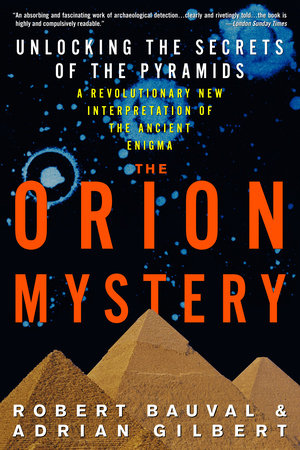
When I read “The Orion Mystery” by Robert Bauval and Adrian Gilbert, probably in 1998, I was very impressed by the analysis by mr Bauval, an engineer like me by the way, of the spirituality of the ancient Egyptians, and their ways of materialising their believes in their artefacts, especially the Cheops pyramids. He seemed to be able to tap into their souls!
For some years I participated in the discussions on the mailing lists on ancient Egypt, and at that time there were three mysteries that caused a lot of discussion:
1. The reason behind slope-angle of the pyramids
2. The purpose of the shafts from the chambers upwards
3. The purpose of the holes in the wall of the Kings Chamber
For all three themes I came up with a theory that might explain them. I only put some calculation work in the first one, wrote it down, and tried to send it to mr Bauval (see part [1]). I remember that it was very hard to find his email address, and that I tried another path, but I forgot what I did exactly. So the email may not have reached mr. Bauval.
I planned to formulate the second one after I had heard from mr Bauval, but since I did not receive a reaction, that did not happen. So, just as a starter, I wrote down the few considerations that I still remember, while building this site, to make this section more complete (see Part [2]). I hope to find time to dig deeper into this soon, and do all proper calculations.
The third one is still “under construction” but the explanation should be obvious to any engineer, so I don’t mind that it is still lacking.
Part [1] (Probably written in 1998 or 1999; no reaction from Mr Robert Bauval was received)
The slope-angle of the pyramids
Dear Mr Bauval,
I am a Dutch engineer and in no way an Egyptologist. My interest in the Giza pyramids was born when I saw a very inspiring documentary about your theories. Since then I have been subscribed to Osirislist and Acelist, two mailing-lists about (a.o.) ancient Egypt.
Lately there have been two discussions on these lists that inspired me to develop new theories about the pyramids. One is about the reason for the 51.8 degree slope-angle of the sides of the great pyramid. The other one is about a possible use of the shafts, but that one was going on some time ago, so if you are interested we might discuss that later.
The issue of the slope-angle is discussed at the moment, but we are running short of information. I decided to write to you, hoping that you would be interested in my theory, and that you might want to help develop it into useful and conclusive material.
Here we go:
Reflective surface of the pyramid
The discussion in the list started about the remark of dr Hawass:
“As part of the millennium celebrations, the Great Pyramid will be fitted with its own electrum covered capstone . . .”
Some thought it would be kitsch, and a crime to do this to the pyramid right now, some agreed that the (top of the?) pyramid may have been gilded when it was built anyway.
I started to think about the implications of a gilded or otherwise reflective surface of the pyramid.
There are two ways it could have been reflective:
– Very white (flat but not polished white stone)
This makes it visible, more or less independent of the angle of the sun and the slope of the pyramid, as a bright white surface, from a long distance, in fact to a maximum of 40 km because of the spherical form of the earth-surface.
– Mirror-like reflective (polished or gilded stone)
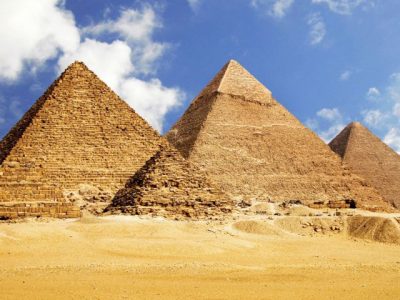
Giza pyramids
This turns the pyramid invisible, since it only reflects the sky. In some special occasions (with the right angle of the sun, combined with the right viewing angle) it would suddenly appear to distant viewers like a sun, lying on earth, almost as bright as the real sun!
I assume that this effect would have been extremely magic to the old Egyptians.
When marble-like polished stones were used, the truth is probably a mixture of both, making the pyramid well visible from all sides, but adding a (less strong) sun-reflection to the south at a certain moment. Electrum on a polished surface would make a perfect mirror of it.
Maybe only the top part was covered with electrum, because the lower part can only be seen from closer by, because of the curvature of the earth surface.
I concentrated on the mirror-like reflection.
First I tried to find out when this special moment of sun-on-earth would occur.
From an illustration in ‘The Orion Mystery’ I know that the slope-angle of the sides of the great pyramid is atan 127/100 = 51,75 degrees.
This causes a horizontal reflection of the sun when it is shining 13.5 degrees from vertical.
Tropic of cancer was at app. 24 degrees north, 4500 years ago, and Giza is at 30 degrees north. This causes a vertical angle of 6 degrees of the sun at midsummer day, and a bigger one on all other days. The 13,5 degree angle would occur app. 6 weeks before and after midsummer day.
So the sun would decend to earth in the beginning of May, and leave again in the beginning of August. In those three months, the light would be reflected to the plateau south of Giza. At the solstice, the focus of the light would be closest to the pyramid, probably at app one km.
Maybe that was the moment the sun was here to pick up the pharaoh to bring him to his place in the sky?
Some in the list objected, saying that the 51,75 degrees are accounted for by the natural slope of sand, chosen by the architects to make the pyramid more stable.
As an engineer I don’t see any connection between a pile of sand and the stability of a stone pyramid. On top of that, each kind of sand has it’s own slope. In my opinion the sun-on-earth theory is much more likely and interesting.
But there is more.
Light technology behind the reflection
The Egyptians determined the north with the help of the pole star. But they did not have laser beams or instruments to keep this direction fixed during the building of the pyramid in daytime. It is very likely that they used mirrors and sunlight to keep lines straight, and to set up the building site. How else could they achieve an accuracy of appr. 1cm on the corners and squareness?
So I think they started building the pyramid with mirrored light beams to an observer who had taken his position based on the north star during the night, exactly 5,3 km (I’ll explain later) to the south from the center of the planned pyramid.
To get a strictly east-west orientated base line, a series of stones would have to be cut to 51,75 degrees vertically, and polished and gilded. They would be put in a more or less east-west row, and the observer would be sent to his place in the south. From there he would give instructions about how to put the stones to make them reflect the sun to him at noon exactly, starting with the middle one.
If he only got the stone in the middle right in time, and the sun started descending, he could change his position (climb higher up his ladder, somewhat to one side) to stay in focus of the first stone and guide the process of positioning the next stone, until the whole row would be exactly east-west.
When doing this, they would find out that it would be necessary to give each stone a very small angle to the next one. Either ugly seams would occur, or the stones would have to be put in a parabolic curve very close to a circle-part. Knowing the way they valued the seams to be perfect, it is no surprise that they decided to put the stones in the very slight curve, that can be observed still.
The next layer of stones can be orientated in the same way on top of them. Only the slope would have to be a very little bit steeper.
The result would be a pyramid-side that was extremely accurately east-west orientated, with a slightly hollow-curved surface.
The fact that the slope angle of the pyramid allowed the builders to use the sun as a construction aid during three months each summer may be a lucky coïncedence, but more likely it is the original reason behind the exact slope angle.
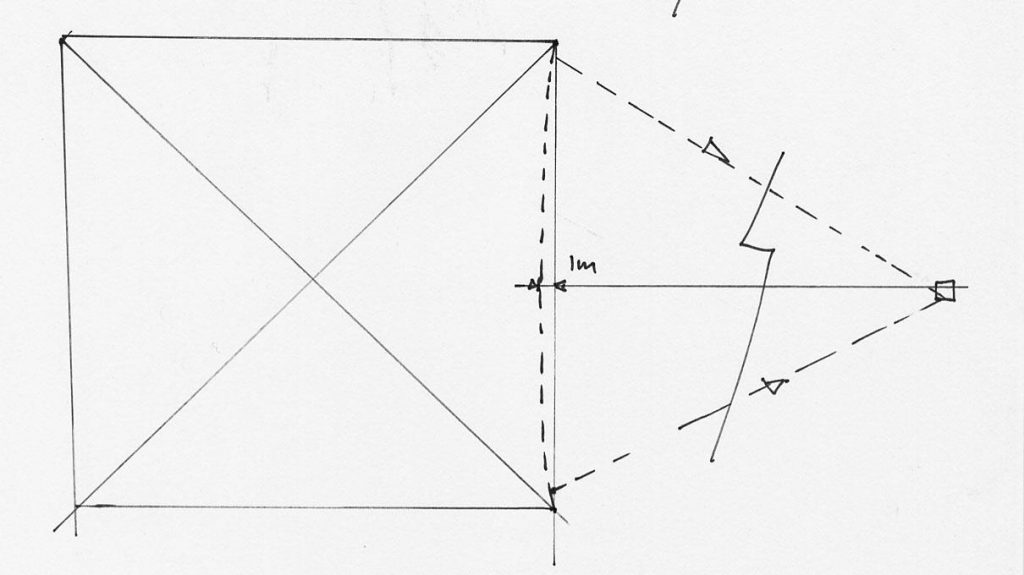
Observed one meter curve in south side of grand pyramid
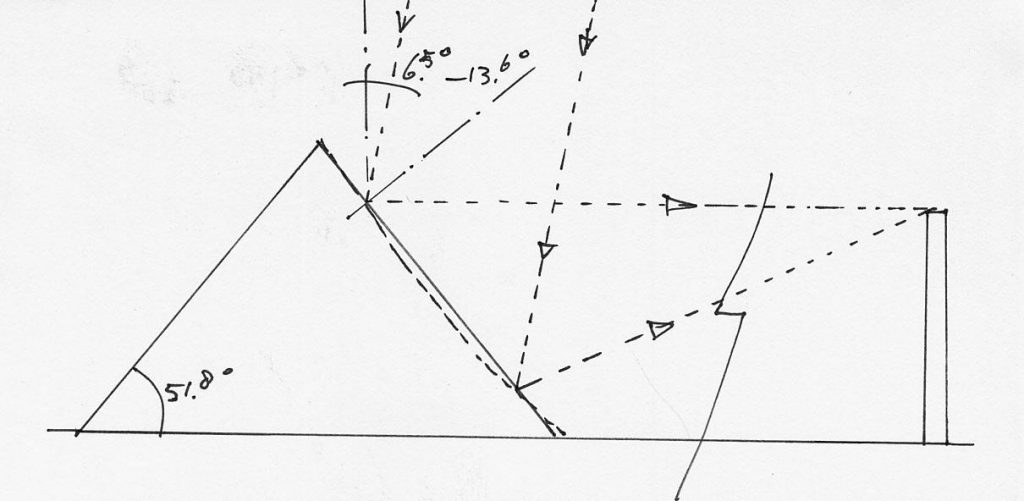
Parallel sunbeams concentrate on an observer on midsummer day
Since the base of the pyramid indeed appears to have a 1m curve in it, I decided to do some calculations. I found out that (with the data as I have them) this curve and the top of the pyramid define a paraboloid mirror that would focus all light that would fall on the pyramid-side from an angle 13.67 degrees (south from vertical), to one point of focus at 5364 m (horizontally) south of the pyramid.
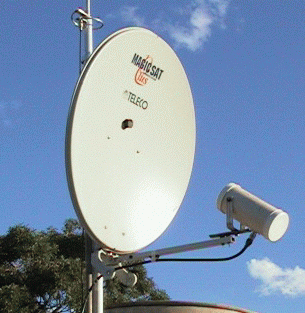
An elliptical paraboloid concentrates parallel beams to one point
First Concentrated Solar Power Plant
It may have been an unintended effect (they just wanted to have a ‘sun-on-earth’ shining to the south on a certain day or period) but what they built was a horrifying machine, as the observer would find out as soon as the number of pointed stones would increase!
With a well reflecting, completed pyramid and the 7kW/m2 of sunlight that would be normal at noon that day, there would be 275 megawatt of energy focused on the observer, the energy of half a present coal power plant, enough to vaporise the poor man in a split second.
In fact this would have been the first CSP (concentrated solar power) plant in history!
Although this is an exciting story I doubt if they succeeded in really focusing much of the energy. But only 1 % of 275 MW would already melt anything that was close to the point of focus.
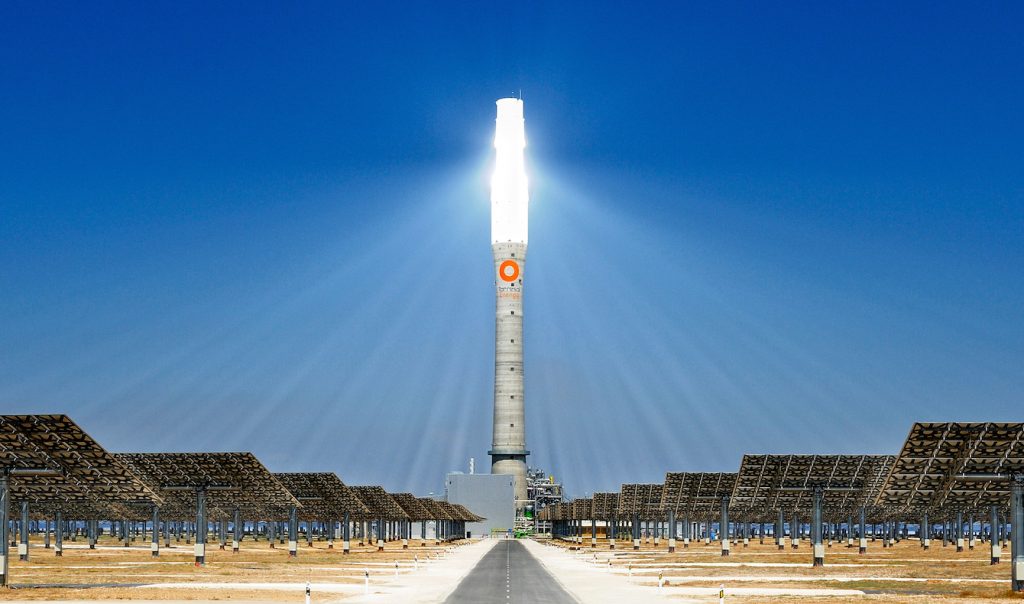
CSP plant, (photo Cluster Energeia)
Still, even if they hardly got any energy focused, or they spread it over too big a surface to have the extreme results mentioned above (which would in fact be very difficult when using this method of focusing!) the slope- angle and apparently paraboloid shape of the side of the pyramid would still create a sun-on-earth phenomenon, which was my point in the first place.
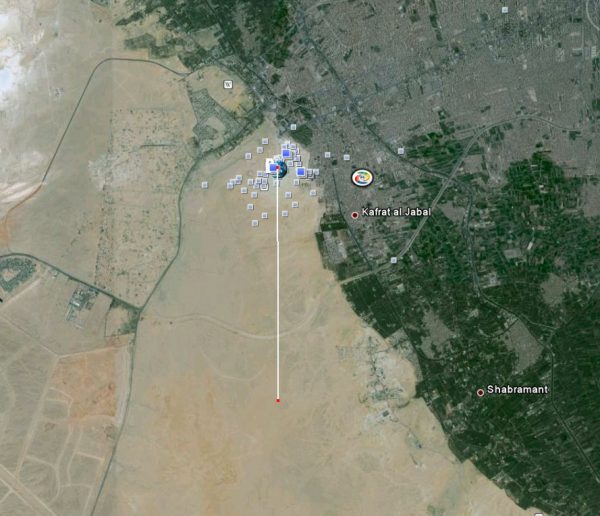
Focusing point of paraboloid, 5340m south of the great pyramid.
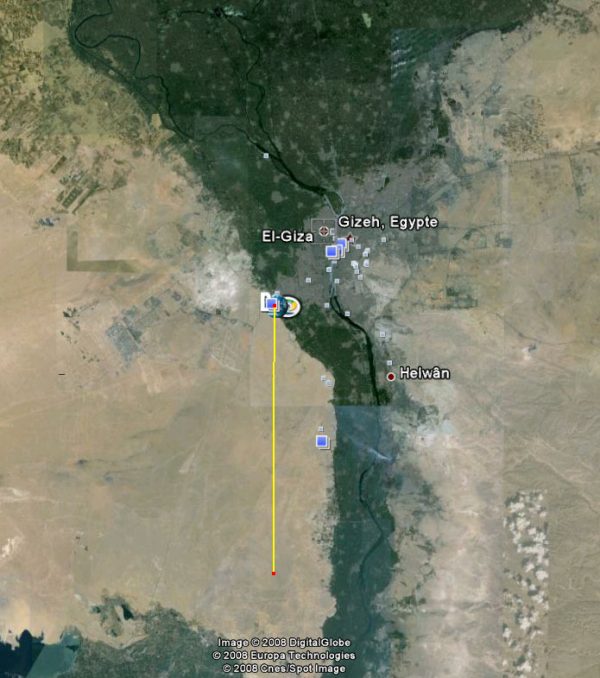
The plateau stretches over 40 km to the south, enabling hundreds of thousands of people to witness the sun descending to earth to collect the dead Pharaoh
The Benben
Let’s take this thought still a bit further, just for fun.
Suppose they incidentally found out about the focusing effect. I assume that they made sure that the observer (= point of focus) was on a high construction. While building the pyramid they covered almost all stones that were not being positioned or needed for the focusing, so the observer would not be fried. In fact, the lower part of the pyramid was automatically covered by the sand that formed the spiraling slopes on which the stones were transported.
After finishing the pyramid they replaced the observatory construction by a high pillar. When in May the reflection started touching the pillar, a special object was put on top of it. Then on the first day of full focus, at noon, this object would first turn red, then white of the heat, then start burning or melting, maybe even vaporizing in a haze of fire. Nobody around would see where the energy came from, they just saw the side directed to the pyramid be lit to a degree that it was impossible to look at.
Imagine the magic!
This event might have started the burail rituals, that in that case would last six weeks.
They might have used meteorites, and drain the molten iron from them, or other ores that were hard to melt in an oven. But most probably there was no technical objective, but just a very special ritual one, and for that they may have used a statue of the Pharao that was intended to soar into the sky, or that of the Phoenix firebird that represented rebirth.
I am sure you now will be able to associate two other things with this theory: the pillar could be an obelisk, and the object the famous sacred Benben!
If the pillar was in fact a square obelisk, any object that would melt on top of it, would take the form of a Benben: a four sided pyramid with rounded edges.
Considering the many associations between the Benben and the obelisk that already exist, this is quite a plausible explanation.
In fact, at the time of the pyramids the Benben mysteriously took the place of the Phoenix, the firebird(!) as the symbol of rebirth, and became the most sacred object. On top of that, it was kept in the temple of Phoenix!
That was a remarkable change, that would be so much better understood if the Benben was a solid object that spontaneously had changed into fire at Midsummer Day at the top of an obelisk during the ceremony of sending the Pharaoh to his place in the skies!
Maybe before melting it even wás the Phoenix.
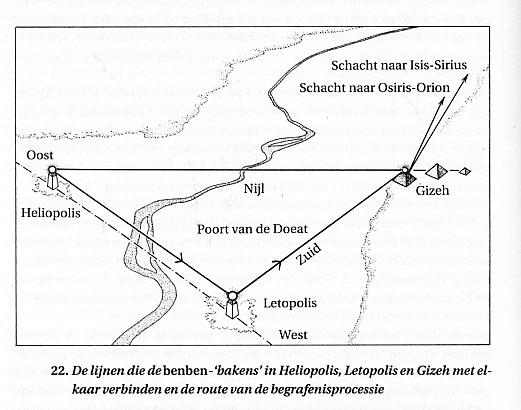
Bauval already assumes “light lines” between Benbens in his book , but to the north.
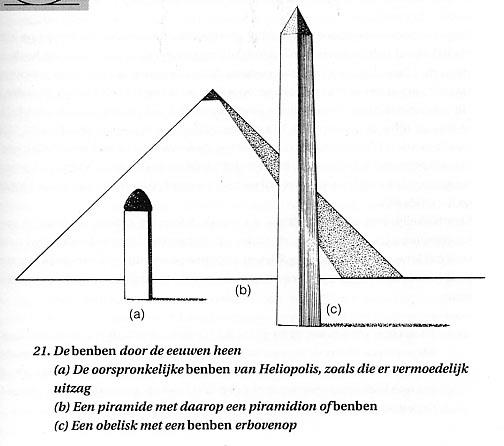
Benbens through time
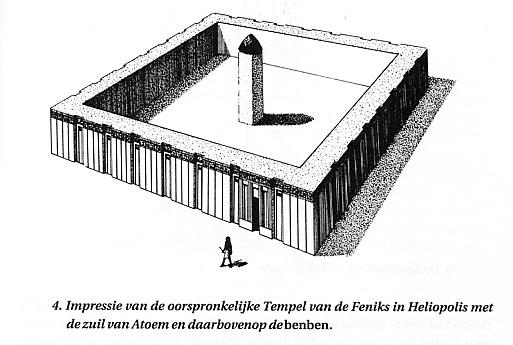
Impression of the original Temple of Phoenix with the pillar with the sacred Benben
Request
To examine the sun-on-earth theory it is necessary to have more accurate data about the slope of the capstone surface of the pyramid when it was built.
To find out about the way they built the mirror, and if there was in fact a point of focus I would also need more specific data on the curves in the surface (horizontally and vertically).
Can you get me this information?
Apart from that, I am very interested to hear what you think about my theory.
I would surely like the theory to be supported by some ancient writings describing a ‘sun-on-earth’-like phenomenon. Do you happen to know any?
Maybe some of the known texts would need to be read in a different way to see the connection.
If there are also descriptions of a ritual concerning much heat or blinding light, this would be very exciting and supportive of the focusing theory…
Conclusion:
If the millennium will be celebrated in Giza on midsummer day, and they covered the south-side of the GP with electrum-coated capstones, I would advise you to refuse an invitation to sit down with Mr Hawass and the other officials, if the stage is a couple of miles south of the pyramid!
With kindest regards,
Theo Wolters
Disclaimer
As a ‘disclaimer’ I should add that I am no mathematician, and that my calculations have not been checked by anyone. So it would be dangerous to consider them as anything more than ‘possibilities’ for the time being.
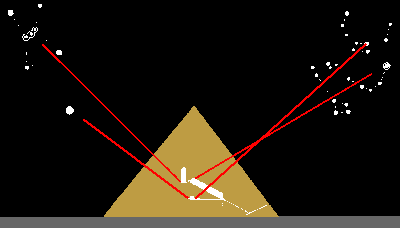 Part [2]
Part [2]
The mysterious shafts from the chambers
As mr Bauval explains in his book, the shafts point at several stars that were important for Egyptians. Especially the Orion region, where most of the new stars seem to appear. The Egyptians, who expected their buried pharaoh to transform to a new star in the sky after the ceremonies, were of course very interested in this part of the sky. But to look at the sky, you don’t need a long shaft. So what does…?
My idea was that the shafts, pointed at the sky, ending in a very dark room, once were part of an observatory, based on the Camera Obscura principle: if you let light fall through a tiny hole in the wall of a dark chamber, it produces a mirrored image of the outside world on the opposite wall.
If you block all light of other stars than the ones you are interested in, the room stays darker and the image gets clearer. This allows a smaller hole which increases the sharpness of the image. This blocking can be done by using a long shaft. And by moving the plate with the tiny hole in it through the shaft, you can actually zoom in or out.
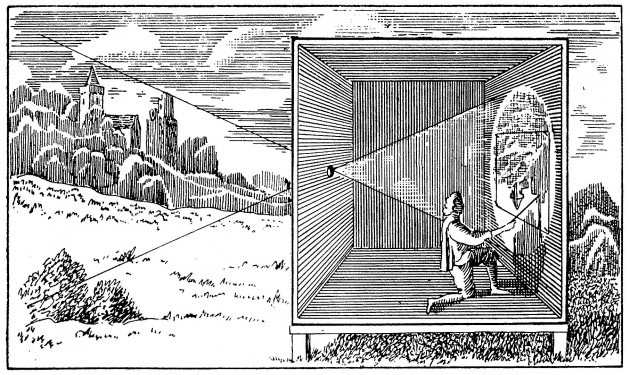 The observatory could have been used to exactly determine the relative position of the stars of Orion as a basis for the layout of the pyramids. You simply put a white, polished plate of marble on the right spot, wait for the moment that Orion appears, and then you carefully and accurately scratch the image in the marble.
The observatory could have been used to exactly determine the relative position of the stars of Orion as a basis for the layout of the pyramids. You simply put a white, polished plate of marble on the right spot, wait for the moment that Orion appears, and then you carefully and accurately scratch the image in the marble.
You can also observe the sky of the Orion region before and after the burial, waiting to see a new star appear. And of course register it’s place on a marble plate or a paper map.
These two uses would require different shafts though: a 60m shaft of 20cm diameter only observes a very small part of the sky, even if the camera hole is in the middle. The observation angle would be less than half a degree. I think that that will only show stars that ar e quite close to eachother. I should do some more calculations on that.
However, the observatory may have preceded the (present) Cheops pyramids by thousands of years. Most likely much smaller pyramids or other constructions would have been built then, reducing the length of the shafts, and increasing the visible area. Later, during restauration to a larger version of the pyramid on the same spot, they could have extended the shafts, merely as ventilation channels. The diameter may also have been reduced during these activities, to make sure they would never be used by grave robbers to get access to the chambers. 20 x 20cm seems to do just that.
Leave A Comment